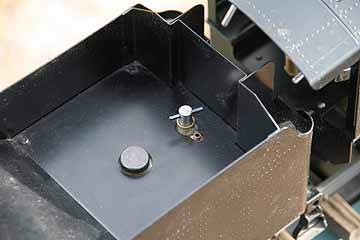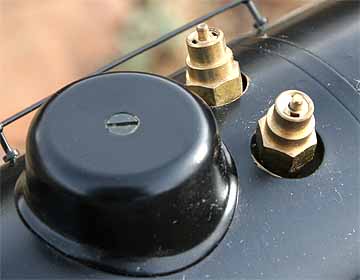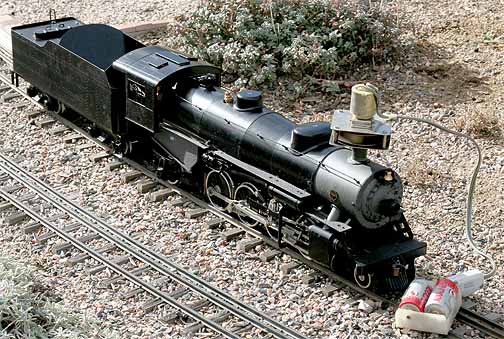
Back to Loco of the Month homepage
Back to Sidestreet Bannerworks
.
January 2006
Aster's USRA Mikado
by Marc Horovitz

In 1918. due to WWI, the US government took control of all railroads. The agency that managed them was the USRA, or the United States Railroad Administration. During the two years of its existence, the USRA was responsible for designing several classes of locomotives. Most of these proved to be excellent designs that were popular with the railroads.
Two classes of Mikado (2-8-2) were produced, light and heavy. Of the light Mikados (which Aster has modeled), 625 were built during the war, and about the same number of copies after the war. In all, over 50 railroads used these engines.
The model
I believe that this Japanese model of an American locomotive is a classic example of British gauge-1 technology. With the exception of its more recent JvR type-B boiler, the design could easily have come out of England in the 1940s or 50s. It is alcohol fired, with the fuel carried in the tender. Alcohol is fed to a three-wick burner in the firebox through a traditional chicken-feed system. Backhead fittings include a throttle, blower valve, pressure gauge, water glass, and a check valve for filling the boiler with an external pump. Reversing gear is Walschaerts, controlled from the cab. A pair of safety valves are mounted atop the boiler. The design of the engine is simple and direct, making it reliable and easy to operate.
The boiler is a type B, as designed by John van Riemsdijk. It's a copper barrel with fire tubes that penetrate the flue sheet at the front end of the boiler. At the rear, they curve down and exit the boiler in the firebox. This type of boiler is both efficient and relatively simple to build. (Aster has used it before on locomotives.)
The engine's big failing, as supplied, is that it didn't come with a pump. Locomotives of this sophistication usually have at least a hand pump in the tender, and often an axle pump with a bypass system as well. In an effort to keep costs down, these were omitted from this model, although an eccentric for an axle pump was included on the second axle. The axle pump was available separately.
This engine was re-released in 2000 in Southern Railway green, complete with both pumps and additional details (at greater expense). In all, 400 of the USRA Mikado were made—260 in black and 140 in green.
I purchased mine as a kit. Aster's kits are always good, but I thought this one exceptionally so. Although still a fairly complex locomotive, the kit went together easily and smoothly. Construction problems were minimumal. The engine is adequately detailed, but isn't loaded with a lot of delicate parts, which I consider an asset. It can be easily handled without risk.
The run
The temperature on the “Loco o' the Month" run day was in the forties, the thin light of the winter solstice filtering down. After oiling all around, filling the lubricator (a dummy air tank under the running board), and topping up the alcohol tank in the tender, I filled the boiler with distilled water through one of the safety valves, as I didn't have an external pump to hook up to the supplied fitting. I placed the engine on the track, stuck the suction fan in the stack, opened the fuel valve, and lit the fire.
Steam came up in short order, and I opened the blower and removed the fan. When the pressure rose to about 40 psi, I opened the throttle and moved the engine back and forth a few times to warm and clear the cylinders. When the engine showed signs of life, I opened the switch to the mainline and turned the engine loose.
After some initial, inexplicable surging problems, the engine settled down to a fine, smooth, steady run. It went around, lap after lap, until the water got low. Since I had no way of refilling the boiler under pressure, I had no choice but to extinguish the fire and let the pressure drop.
During the run I noticed some unexplained squeaks. I thought that I'd lubricated the engine pretty thoroughly, but something was evidently rubbing someplace. After the run, close examination revealed two problems. One of the dummy brake shoes was rubbing against a driver, which was easily remedied. The other, louder squeak came from the tender's suspension. I had not oiled the bolsters where they ride in the sideframes. It's always something!.
|
|
|
| Builder | Aster |
| Date built | 1999 |
| Gauge | 1 (45mm) |
| Scale | 1:32 |
| Boiler | Internally fired, JvR type B |
| Fittings | Safety valves (2), throttle, blower, water glass, pressure gauge, check valve |
| Fuel | Alcohol |
| Blow-off pressure | 60 psi |
| Cylinders | Two, double-acting D-valve |
| Reversing gear | Walschaerts |
| Lubricator | Displacement (dead leg) |
| Weight | 15 pounds, 8 ounces (loco and tender) |
| Dimensions | Length, 30-1/4" (loco and tender); width, 4"; height, 6-1/2" |

Above and below: Two sides of the same story. The engine was supplied painted but unlettered, its attractive lines relatively unadorned.
.




The alcohol tank resides in the front of the tender. It is filled through a plug in the coal bunker. The valve controls its flow to the sump.
.
The pressure gauge is visible through the fireman's window, which is fine as long as you're on that side of the train. If not, a dental mirror is resorted to.
.


Above: The interior of the cab is packed full. The aft section of the roof swings up for access. A large-diameter water glass makes for accurate readings. One handle on the brass manifold is the blower, while the other is the throttle.
Right: A pair of safety valves reside atop the boiler.
.


Without and axle pump and its associated plumbing, the underside of the locomotive is simple and straightforward. On the second drive axle, near the top, you can see the eccentric that could be used for an axle pump. The three burners are clearly visible.
.

Back to Loco of the Month home page
Back to Sidestreet Bannerworks home page
This page and its contents
Copyright Sidestreet Bannerworks, 2006
.